英语八大时态用法详解
- 格式:doc
- 大小:35.73 KB
- 文档页数:7
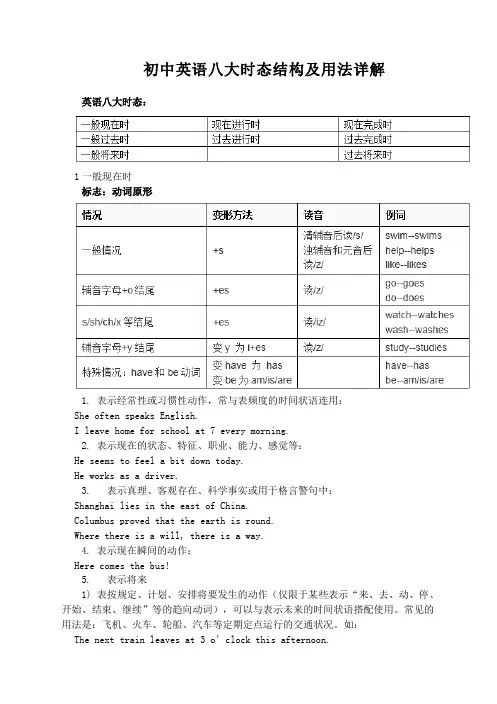
初中英语八大时态结构及用法详解英语八大时态:1一般现在时标志:动词原形1. 表示经常性或习惯性动作,常与表频度的时间状语连用:She often speaks English.I leave home for school at 7 every morning.2. 表示现在的状态、特征、职业、能力、感觉等:He seems to feel a bit down today.He works as a driver.3. 表示真理、客观存在、科学事实或用于格言警句中:Shanghai lies in the east of China.Columbus proved that the earth is round.Where there is a will, there is a way.4. 表示现在瞬间的动作:Here comes the bus!5. 表示将来1) 表按规定、计划、安排将要发生的动作(仅限于某些表示“来、去、动、停、开始、结束、继续”等的趋向动词),可以与表示未来的时间状语搭配使用。
常见的用法是:飞机、火车、轮船、汽车等定期定点运行的交通状况。
如:The next train leaves at 3 o’clock this afternoon.How often does the shuttle bus run?2) 在时间和条件状语从句中常使用一般现在时表示将来发生的事情:When Bill comes (不用will come), ask him to wait for me.I shall go there tomorrow unless I’m too busy.2一般过去时标志:动词过去式*闭音节:元音字母a, e, i, o, u如果发字母本来的音则称为开音节,否则称为闭音节。
1. 表示过去某时所发生的动作或存在的状态,常与表示过去的时间状语连用(e.g. yesterday, this morning, just now, a moment ago, in May, last night / year / week, once upon a time, the other day, before …, when …, in the past等)。
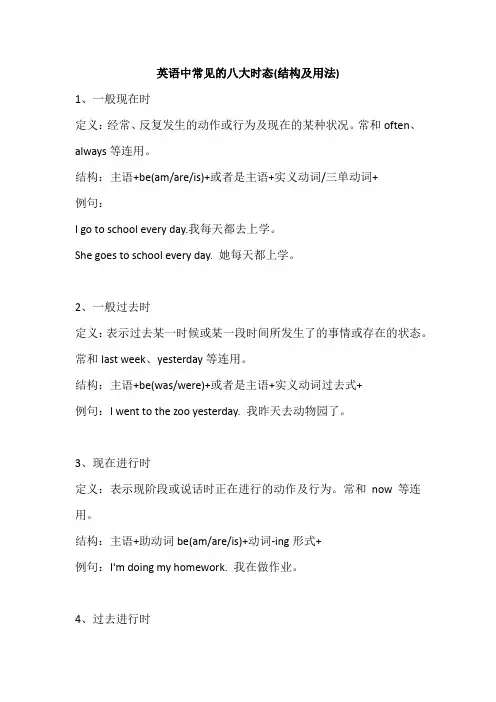
英语中常见的八大时态(结构及用法)1、一般现在时定义:经常、反复发生的动作或行为及现在的某种状况。
常和often、always等连用。
结构:主语+be(am/are/is)+或者是主语+实义动词/三单动词+例句:I go to school every day.我每天都去上学。
She goes to school every day. 她每天都上学。
2、一般过去时定义:表示过去某一时候或某一段时间所发生了的事情或存在的状态。
常和last week、yesterday等连用。
结构:主语+be(was/were)+或者是主语+实义动词过去式+例句:I went to the zoo yesterday. 我昨天去动物园了。
3、现在进行时定义:表示现阶段或说话时正在进行的动作及行为。
常和now等连用。
结构:主语+助动词be(am/are/is)+动词-ing形式+例句:I'm doing my homework. 我在做作业。
4、过去进行时定义:表示在过去某个时间点发生或进行的行为的事情。
常和at this time yesterday等或以when引导的谓语动词连用。
结构:主语+助动词be(was/were)+动词-ing形式+例句:When I got to the top of the mountain, the sun was shining. 我到达山顶时,阳光灿烂。
5、现在完成时定义:表示过去发生的动作对现在造成的影响或结果或过去的动作或状态持续到现在。
构成:主语+助动词(have/has)+动词过去分词+例句:I have lived here for more than twenty years. 我住在这儿二十多年了。
6、过去完成时定义:表示在过去某一时刻或动作以前完成了的动作,也可以说过去的时间关于过去的动作。
构成:主语+助动词(have/has)+动词过去分词+例句:She said she had never been to Paris. 她告诉我她曾去过巴黎。
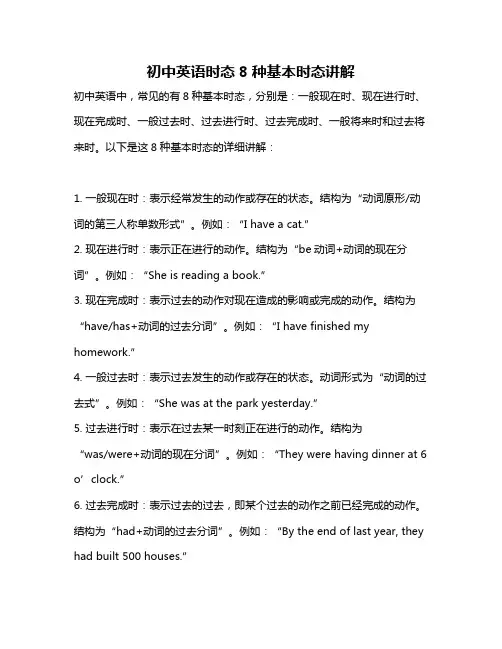
初中英语时态8种基本时态讲解初中英语中,常见的有8种基本时态,分别是:一般现在时、现在进行时、现在完成时、一般过去时、过去进行时、过去完成时、一般将来时和过去将来时。
以下是这8种基本时态的详细讲解:1. 一般现在时:表示经常发生的动作或存在的状态。
结构为“动词原形/动词的第三人称单数形式”。
例如:“I have a cat.”2. 现在进行时:表示正在进行的动作。
结构为“be动词+动词的现在分词”。
例如:“She is reading a book.”3. 现在完成时:表示过去的动作对现在造成的影响或完成的动作。
结构为“have/has+动词的过去分词”。
例如:“I have finished my homework.”4. 一般过去时:表示过去发生的动作或存在的状态。
动词形式为“动词的过去式”。
例如:“She was at the park yesterday.”5. 过去进行时:表示在过去某一时刻正在进行的动作。
结构为“was/were+动词的现在分词”。
例如:“They were having dinner at 6 o’clock.”6. 过去完成时:表示过去的过去,即某个过去的动作之前已经完成的动作。
结构为“had+动词的过去分词”。
例如:“By the end of last year, they had built 500 houses.”7. 一般将来时:表示将来要发生的动作或存在的状态。
结构为“will+动词原形”或“am/is/are going to+动词原形”。
例如:“We will visit the museum next week.”8. 过去将来时:表示从过去的某一时刻看,将来要发生的动作或存在的状态。
结构为“would+动词原形”或“was/were going to+动词原形”。
例如:“He said he would come back soon.”以上就是初中英语8种基本时态的讲解,希望对你有帮助!。

初中英语必考八大时态结构及用法详解一.一般现在时1. 概念:经常、反复发生的动作或行为及现在的某种状况。
2. 基本结构:①is/am/are;②do/does否定形式:①am/is/are+not; ②此时态的谓语动词若为行为动词,则在其前加don't,如主语为第三人称单数,则用doesn't,同时还原行为动词。
3. 一般疑问句:①把is/am/are 动词放于句首;②用助动词do 提问,如主语为第三人称单数,则用does,同时,还原行为动词。
4. 用法1)经常性或习惯性的动作,常与表示频度的时间状语连用。
例如:I leave home for school at 7 every morning. 每天早上我七点离开家。
2)客观真理,客观存在,科学事实。
例如:The earth moves around the sun. 地球绕太阳转动。
Shanghai lies in the east ofChina. 上海位于中国东部。
3)表示格言或警句。
例如:Pride goes before a fall 骄者必败。
注意:此用法如果出现在宾语从句中,即使主句是过去时,从句谓语也要用一般现在时。
例如:Columbus proved that the earth is round. 哥伦布证实了地球是圆的。
4)现在时刻的状态、能力、性格、个性。
例如:I don't want so much. 我不要那么多。
Ann writes good English but does not speak well.安英语写得不错,讲的可不行。
5)一般现在时表示将来含义。
a. 下列动词come, go, arrive, leave, start, begin, return 的一般现在时可以表示将来,主要用来表示在时间上已确定或安排好的事情。
例如:The train leaves at six tomorrow morning. 火车明天上午六点开。
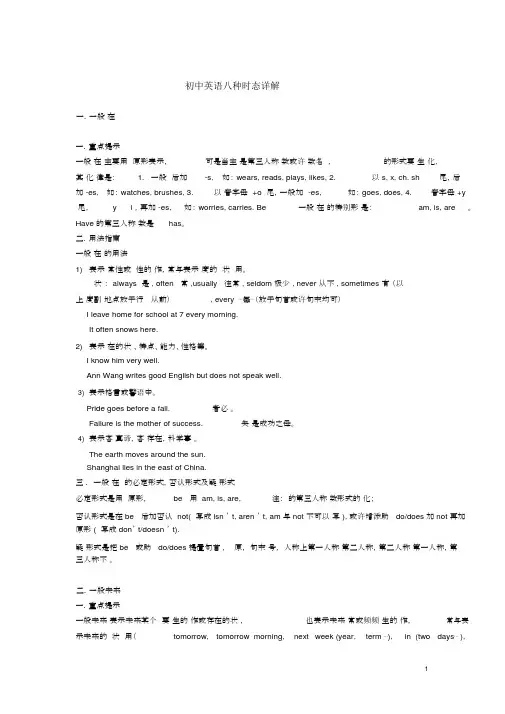
初中英语八种时态详解一.一般在一.重点提示一般在主要用原形表示,可是当主是第三人称数或许数名,的形式要生化,其化律是: 1.一般后加-s,如:wears, reads, plays, likes, 2.以s, x, ch, sh尾,后加 -es,如:watches, brushes, 3.以音字母+o尾,一般加-es,如:goes, does, 4.音字母+y 尾,y i ,再加 -es,如:worries, carries. Be一般在的特别形是:am, is, are。
Have 的第三人称数是has。
二.用法指南一般在的用法1)表示常性或性的作,常与表示度的状用。
状: always 是 , often 常 ,usually 往常 , seldom 极少 , never 从不 , sometimes 有(以上度副地点放于行从前), every ⋯每⋯(放于句首或许句末均可)I leave home for school at 7 every morning.It often snows here.2)表示在的状、特点、能力、性格等。
I know him very well.Ann Wang writes good English but does not speak well.3)表示格言或警语中。
Pride goes before a fall.者必。
Failure is the mother of success.失是成功之母。
4)表示客真谛,客存在,科学事。
The earth moves around the sun.Shanghai lies in the east of China.三 .一般在的必定形式,否认形式及疑形式必定形式是用原形,be 用 am, is, are,注:的第三人称数形式的化;否认形式是在 be 后加否认 not( 写成 isn ’ t, aren ’ t, am 与 not 不可以写 ), 或许增添助 do/does 加 not 再加原形 ( 写成 don’ t/doesn ’ t).疑形式是把 be 或助 do/does 提置句首 , 原,句末号,人称上第一人称第二人称,第二人称第一人称,第三人称不。
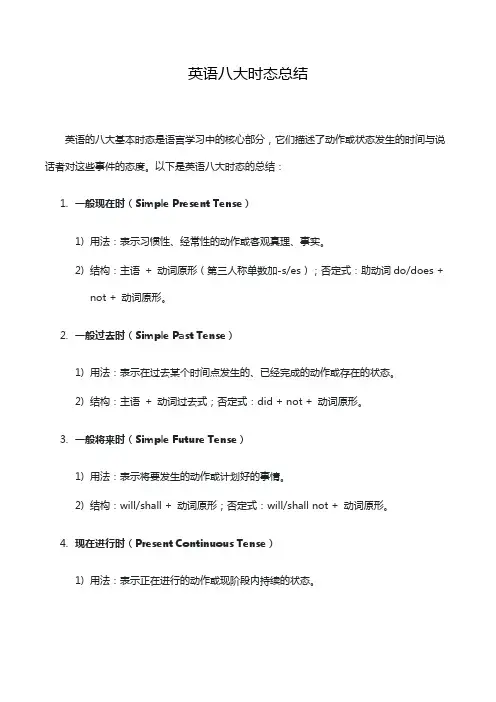
英语八大时态总结英语的八大基本时态是语言学习中的核心部分,它们描述了动作或状态发生的时间与说话者对这些事件的态度。
以下是英语八大时态的总结:1.一般现在时(Simple Present Tense)1)用法:表示习惯性、经常性的动作或客观真理、事实。
2)结构:主语+ 动词原形(第三人称单数加-s/es);否定式:助动词do/does +not + 动词原形。
2.一般过去时(Simple Past Tense)1)用法:表示在过去某个时间点发生的、已经完成的动作或存在的状态。
2)结构:主语+ 动词过去式;否定式:did + not + 动词原形。
3.一般将来时(Simple Future Tense)1)用法:表示将要发生的动作或计划好的事情。
2)结构:will/shall + 动词原形;否定式:will/shall not + 动词原形。
4.现在进行时(Present Continuous Tense)1)用法:表示正在进行的动作或现阶段内持续的状态。
2)结构:am/is/are + 动词-ing形式;否定式:am/is/are + not + 动词-ing形式。
5.过去进行时(Past Continuous Tense)1)用法:表示过去某段时间内正在进行的动作或背景。
2)结构:was/were + 动词-ing形式;否定式:was/were + not + 动词-ing形式。
6.现在完成时(Present Perfect Tense)1)用法:表示过去发生的动作对现在的影响或从过去一直持续到现在的情况。
2)结构:have/has + 过去分词;否定式:have/has + not + 过去分词。
7.过去完成时(Past Perfect Tense)1)用法:表示在过去的某一时间之前已经完成的动作。
2)结构:had + 过去分词;否定式:had + not + 过去分词。
8.将来完成时(Future Perfect Tense)1)用法:表示在将来某一时刻之前将要完成的动作。
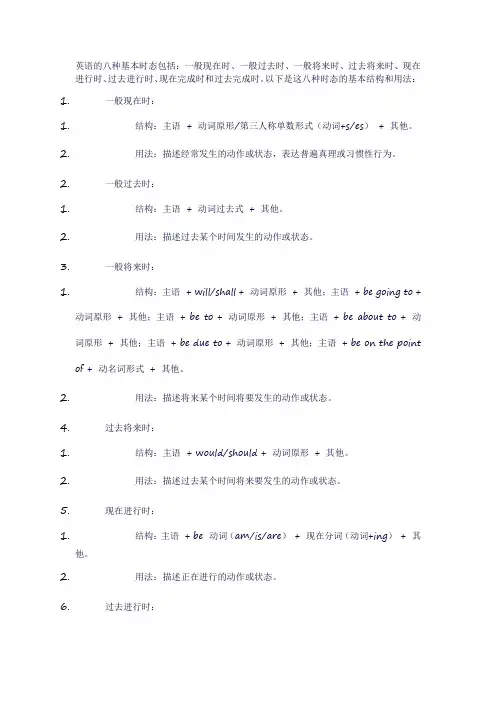
英语的八种基本时态包括:一般现在时、一般过去时、一般将来时、过去将来时、现在进行时、过去进行时、现在完成时和过去完成时。
以下是这八种时态的基本结构和用法:1.一般现在时:1.结构:主语+ 动词原形/第三人称单数形式(动词+s/es)+ 其他。
2.用法:描述经常发生的动作或状态,表达普遍真理或习惯性行为。
2.一般过去时:1.结构:主语+ 动词过去式+ 其他。
2.用法:描述过去某个时间发生的动作或状态。
3.一般将来时:1.结构:主语+ will/shall + 动词原形+ 其他;主语+ be going to +动词原形+ 其他;主语+ be to + 动词原形+ 其他;主语+ be about to + 动词原形+ 其他;主语+ be due to + 动词原形+ 其他;主语+ be on the point of + 动名词形式+ 其他。
2.用法:描述将来某个时间将要发生的动作或状态。
4.过去将来时:1.结构:主语+ would/should + 动词原形+ 其他。
2.用法:描述过去某个时间将来要发生的动作或状态。
5.现在进行时:1.结构:主语+ be 动词(am/is/are)+ 现在分词(动词+ing)+ 其他。
2.用法:描述正在进行的动作或状态。
6.过去进行时:1.结构:主语+ be 动词的过去式(was/were)+ 现在分词(动词+ing)+ 其他。
2.用法:描述过去某个时间点正在进行的动作或状态。
7.现在完成时:1.结构:主语+ have/has + 过去分词(动词+ed)+ 其他。
2.用法:描述过去发生的动作对现在造成的影响或结果,或者表示从过去某一时间开始一直持续到现在的情况。
8.过去完成时:1.结构:主语+ had + 过去分词(动词+ed)+ 其他。
2.用法:描述过去某个时间点之前已经完成的动作或状态,或者表示一个过去的动作在另一个过去的动作之前发生。
请注意,以上列出的时态结构和用法是基本的概述,实际使用中可能因语境和习惯而有所不同。
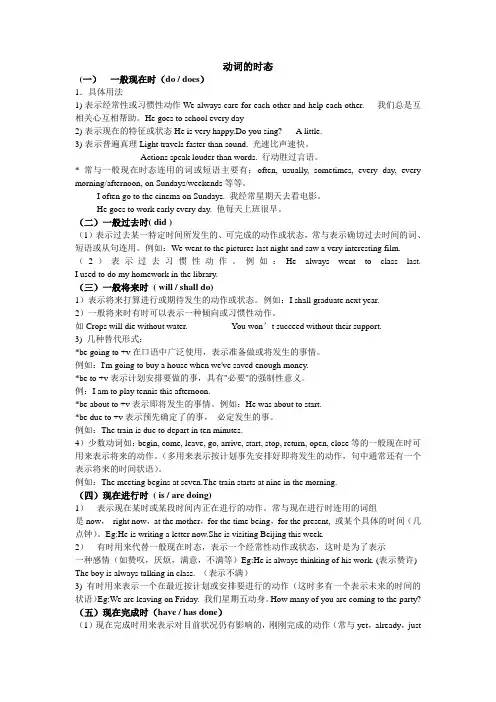
动词的时态(一)一般现在时(do / does)1.具体用法1)表示经常性或习惯性动作We always care for each other and help each other. 我们总是互相关心互相帮助。
He goes to school every day2)表示现在的特征或状态He is very happy.Do you sing? ----A little.3)表示普遍真理Light travels faster than sound. 光速比声速快。
Actions speak louder than words. 行动胜过言语。
* 常与一般现在时态连用的词或短语主要有:often, usually, sometimes, every day, every morning/afternoon, on Sundays/weekends等等。
I often go to the cinema on Sundays. 我经常星期天去看电影。
He goes to work early every day. 他每天上班很早。
(二)一般过去时( did )(1)表示过去某一特定时间所发生的、可完成的动作或状态,常与表示确切过去时间的词、短语或从句连用。
例如:We went to the pictures last night and saw a very interesting film. (2)表示过去习惯性动作。
例如:He always went to class last.I used to do my homework in the library.(三)一般将来时( will / shall do)1)表示将来打算进行或期待发生的动作或状态。
例如:I shall graduate next year.2)一般将来时有时可以表示一种倾向或习惯性动作。
如Crops will die without water. You won’t succeed without their support.3) 几种替代形式:*be going to +v在口语中广泛使用,表示准备做或将发生的事情。
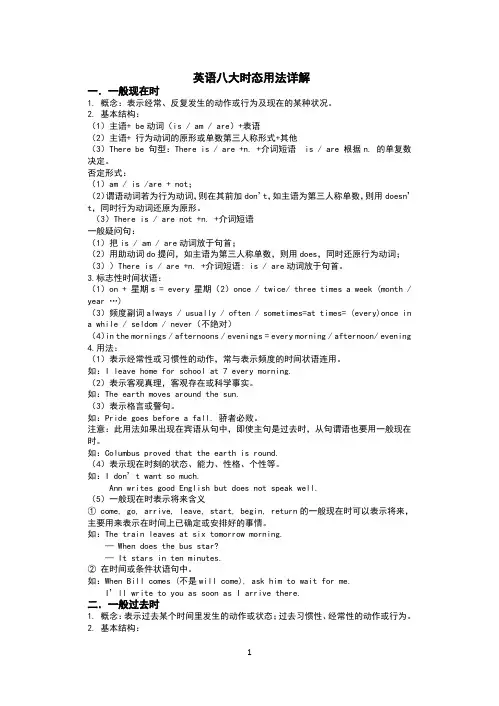
英语八大时态用法详解一.一般现在时1. 概念:表示经常、反复发生的动作或行为及现在的某种状况。
2. 基本结构:(1)主语+ be动词(is / am / are)+表语(2)主语+ 行为动词的原形或单数第三人称形式+其他(3)There be 句型:There is / are +n. +介词短语 is / are 根据n. 的单复数决定。
否定形式:(1)am / is /are + not;(2)谓语动词若为行为动词,则在其前加don’t,如主语为第三人称单数,则用doesn’t,同时行为动词还原为原形。
(3)There is / are not +n. +介词短语一般疑问句:(1)把is / am / are动词放于句首;(2)用助动词do提问,如主语为第三人称单数,则用does,同时还原行为动词;(3))There is / are +n. +介词短语: is / are动词放于句首。
3.标志性时间状语:(1)on + 星期s = every 星期(2)once / twice/ three times a week (month / year …)(3)频度副词always / usually / often / sometimes=at times= (every)once in a while / seldom / never(不绝对)(4)in the mornings / afternoons / evenings = every morning / afternoon/ evening 4.用法:(1)表示经常性或习惯性的动作,常与表示频度的时间状语连用。
如:I leave home for school at 7 every morning.(2)表示客观真理,客观存在或科学事实。
如:The earth moves around the sun.(3)表示格言或警句。
如:Pride goes before a fall. 骄者必败。
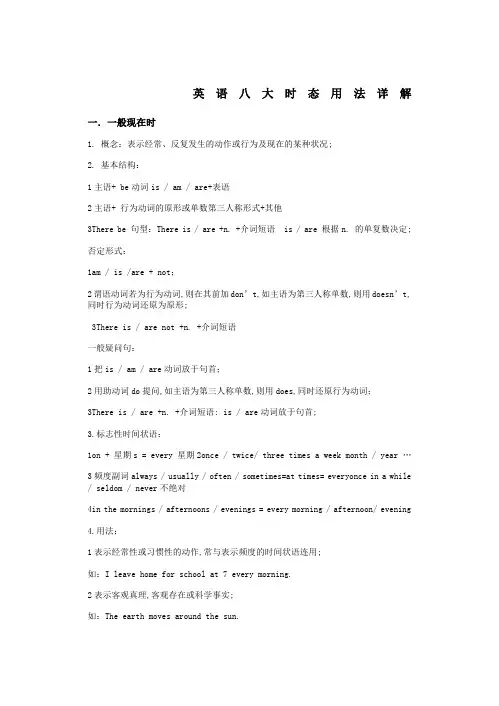
英语八大时态用法详解一.一般现在时1. 概念:表示经常、反复发生的动作或行为及现在的某种状况;2. 基本结构:1主语+ be动词is / am / are+表语2主语+ 行为动词的原形或单数第三人称形式+其他3There be 句型:There is / are +n. +介词短语 is / are 根据n. 的单复数决定;否定形式:1am / is /are + not;2谓语动词若为行为动词,则在其前加don’t,如主语为第三人称单数,则用doesn’t,同时行为动词还原为原形;3There is / are not +n. +介词短语一般疑问句:1把is / am / are动词放于句首;2用助动词do提问,如主语为第三人称单数,则用does,同时还原行为动词;3There is / are +n. +介词短语: is / are动词放于句首;3.标志性时间状语:1on + 星期s = every 星期2once / twice/ three times a week month / year …3频度副词always / usually / often / sometimes=at times= everyonce in a while / seldom / never不绝对4in the mornings / afternoons / evenings = every morning / afternoon/ evening4.用法:1表示经常性或习惯性的动作,常与表示频度的时间状语连用;如:I leave home for school at 7 every morning.2表示客观真理,客观存在或科学事实;如:The earth moves around the sun.3表示格言或警句;如:Pride goes before a fall. 骄者必败;注意:此用法如果出现在宾语从句中,即使主句是过去时,从句谓语也要用一般现在时;如:Columbus proved that the earth is round.4表示现在时刻的状态、能力、性格、个性等;如:I don’t want so much.Ann writes good English but does not speak well.5一般现在时表示将来含义① come, go, arrive, leave, start, begin, return的一般现在时可以表示将来,主要用来表示在时间上已确定或安排好的事情;如:The train leaves at six tomorrow morning.— When does the bus star— It stars in ten minutes.②在时间或条件状语句中;如:When Bill comes 不是will come, ask him to wait for me.I’ll write to you as soon as I arrive there.二.一般过去时1. 概念:表示过去某个时间里发生的动作或状态;过去习惯性、经常性的动作或行为;2. 基本结构:1主语+ was / were +表语2主语+ 行为动词的过去式 +其他3There be 句型:There was / were +n. +介词短语4主语+could+动词原形5主语+used to do sth否定形式:1was / were + not;2在行为动词前加didn’t,同时还原行为动词;3There was / were not +n. +介词短语4主语+could not +动词原形5主语+used not to do sth或主语+didn’t use to do sth一般疑问句:1was或were放于句首;2用助动词do的过去式did 提问,同时还原行为动词;3There was / were +n. +介词短语:was或were放于句首;4could放于句首;5Used主语+ to do sth或Did+主语+use to do sth3.时间状语:1last 短语2时间段+ago 3yesterday及yesterday短语4at the age of = when sb. was+年龄5in one’s teens / twenties6固定短语:just now=a moment ago, one day, from then on, at that time, the day before yesterday, before, long before, in the past , in the / early old days, in the ancient days, in the ancient + 国家,long long ago = once upon a time 故事的开头4. 用法:1在确定的过去时间里所发生的动作或存在的状态;如:Where did you go just now2表示在过去一段时间内,经常性或习惯性的动作;如:When I was a child, I often played football in the street.注意:used to do sth“过去常常做某事”,表示过去习惯性的动作或状态,但如今已不存在;如:Mother used not to be so forgetful. 妈妈过去没这么健忘;3用于时间状语从句a. 由when 引导的时间状语从句,从句用一般过去时态,主句用过去进行时态;如:His mother was cooking when he came back.b. 由since/before 引导的时间状语从句,从句用一般过去时态,主句用现在完成时态;如:I have made many friends since I came to China.It has been/is 15 years since I was a teacher.It has been/is 15 years before he knew it. 不知不觉15 年过去了;c. 由when / by the time/ before引导的时间状语从句,从句用一般过去时态,主句用过去完成时态;如:The plane had taken off when / by the time we arrived at the airport.The Enlish class had begun before I got to school.三.现在进行时1. 概念:表示现阶段或说话时正在进行的动作及行为;2. 基本结构:主语 + am / is /are + doing否定形式:主语 + am / is / are + not + doing一般疑问句:把be动词放于句首;3.时间状语:(1)now 2at this time = at this / the moment 3Look/Look at …4Listen / Listen to …5these days / months / years6It is+ 时间点/日期/星期4. 用法:1表示现在指说话人说话时正在发生的事情;如:We are waiting for you.2表示长期的或重复性的动作,说话时动作未必正在进行;如:Mr Green is writing another novel. 说话时并不一定在写小说3表示动作的渐变,这样的动词有:get, grow, become, turn, run, go, begin等;如:The leaves are turning red.It’s getting warmer and warmer.4与always, constantly, forever 等词连用,表示反复发生的动作或持续存在的状态,往往带有说话人的主观色彩;如:You are always changing your mind. 你老是改变主意;5用现在进行时表示将来下列动词come, go, arrive, leave, start, begin, return等瞬间动词的现在进行时可以表示将来;如:I’m leaving tomorrow.四.过去进行时1. 概念:表示过去某段时间或某一时刻正在发生或进行的行为或动作;如:My brother fell while he was riding his bicycle and hurt himself.2. 基本结构:主语 + was / were + doing否定形式:主语 + was / were + not + doing一般疑问句:把was或were放于句首;3. 时间状语:1at that time2at this time+过去的时间3It was+ 时间点/ 日期/ 星期过去4from A时间 to B时间+过去的时间4. 用法:1过去进行时表示过去某段时间内持续进行的动作或者事情;如:We were watching TV from seven to nine last night.2过去进行时可以表示在过去某个时间点发生的事情;时间点可以用介词短语、副词或从句来表示;如:What was she doing at nine o’clock yesterday 介词短语表示时间点She was doing her homework then. 副词表示时间点When I saw him he was decorating his room. when从句表示时间点3在复合句中,如果主要动作和背景动作都是延续的或同时发生的,那么主从句的动词都可用过去进行时;如:When he was waiting for the bus, he was reading a newspaper. 两个动作都是延续的He was cleaning his car while I was cooking. 两个动作同时进行或主句的动作发生在从句的动作过程中五.一般将来时1. 概念:表示将要发生的动作或存在的状态及打算、计划或准备做某事;2. 基本结构:1主语 + am / is / are / going to do sth2主语 + will do sth3主语 + am / is /are t to do sth 4主语 + am / is /are about to do sth否定形式:1主语 + am / is /are + not + going to do sth2主语 + will notwon’t do sth3主语 + am / is /are not t to do sth 4主语 + am / is /are not about to do sth一般疑问句:1am / is / are放于句首;2will置于句首;3am / is / are放于句首;4am / is / are放于句首;2. 时间状语:1tomorrow及其短语、 the day after tomorrow2next短语3固定短语:one day, someday = some day, in the future, from now / today on, before long, sometime, in +时间段多长时间之后, in following+ 时间段4. will主要用于以下三个方面:1表示主观意愿的将来;如:They will go to visit the factory tomorrow.2表示不以人的意志为转移的客观的将来;如:Today is Saturday. Tomorrow will be Sunday.He will be thirty years old this time next year.3表示临时决定,通常用于对话中;— Mary has been ill for a week.— Oh, I didn’t know. I will go and see her.5. be going to主要用于以下两个方面:1表示事先经过考虑、打算、计划要做某事;如:Dad and I are going to watch an opera this afternoon.今天下午我和爸爸打算去看歌剧;2表示根据目前某种迹象判断,某事非常有可能发生,表示推测;如:Look There come the dark clouds. It is going to rain.6. 用于状语从句由when /as soon as / begore / after 等引导的时间状语从句或者if, unless, as/ so long as 引导的条件状语从句,从句用一般现在时态或从句为祈使句,再或者从句中含有情态动词,主句用一般将来时态;可理解为主将从现、主祈从现、主情从现如:Don’t trouble troubles until trouble troubles you.He will help you out whenever you have problems.I won't go to the partyunlessI'm invited.六.过去将来时1. 概念:立足于过去某一时刻,从过去看将来,常用于宾语从句中;2. 基本结构:1主语 + was / were / going to do sth2主语 + would do sth否定形式:1主语 + was / were / not + going to do sth2主语 + would + not + do sth一般疑问句:1was或were放于句首;2would 提到句首;3. 时间状语:the next day morning, year, the following month week等;4. 用法:1“would + 动词原形”常表示主观意愿的将来;如:He said he would come to see me. 他说他要来看我;2“was / were + going to + 动词原形”常表示按计划或安排即将发生的事;如:She said she was going to start off at once.I was told that he was going to return home.此结构还可表示根据某种迹象来看,很可能或即将发生的事情;如:It seemed as if it was going to rain. 看来好像要下雨;3come,go,leave,arrive,start等瞬时动词可用过去进行时表示过去将来的含义;如:He said the train was leaving at six the next morning.She told me she was coming to see me.七.现在完成时1. 概念:过去发生或已经完成的动作对现在造成的影响或结果,或从过去已经开始持续到现在并且有可能继续下去的动作或状态;3. 基本结构:主语 + have / has + done +其他否定形式:主语 + have / has + not +done +其他一般疑问句:Have / Has +主语 + done +其他4. 时间状语:1already 用于肯定句yet否定句和一般疑问句2just, ever, before, never3so far=up to now = until / till now = by now4over/ in the past /last +时间段5by + 时间6by the end of +现在的时间7since +过去时间如具体的年、月、日、钟点等,如:1980, last month, half past six8 since +一段时间+ ago 9recently = lately10in recent +时间段5. 特殊用法:1由since/before 引导的时间状语从句,从句用一般过去时态,主句用现在完成时态;如:I have made many friends since I came to China.It has been/is 15 years since I was a teacher.It has been/is 15 years before he knew it. 不知不觉15 年过去了;(2)用于由that引导的定语从句中,先行词前有形容词的最高级修饰;如:You’re the best teacher that has ever taught me.6. 比较since和forsince 用来说明动作起始时间,for用来说明动作延续时间的长度;如:We haven’t had any guests since we moved in here.I have lived here for more than twenty years.注意:并非有for 作为时间状语的句子都用现在完成时;I worked here for more than twenty years. 我现在已不在这里工作;7. 延续性动词与非延续性动词之间的转换:leave --- be away from borrow --- keep buy --- have begin/start --- be ondie --- be dead finish --- be over open sth --- keep sth openjoin --- be in+组织机构或be a member of+组织机构fall ill / asleep --- be ill / asleep get up---be upcatch / get a cold --- have a cold come here --- be here go there --- be therebecome / get +adj.--- be+adj come back --- be back get to/ arrive/reach --- be inget to know --- know go get out ---be out put on--- wear/ be in /be dressed in八.过去完成时1. 概念:以过去某个时间为参照,在此以前发生的动作或行为,或在过去某动作之前已完成的动作,即“过去的过去”;2. 基本结构:主语 + had done +其他否定形式:主语 + hadn’t done +其他一般疑问句:had置于句首;3. 时间状语:before, by the end of last yearterm, month等;4. 用法:1用于told, said, knew, heard, thought等动词后的宾语从句中;如:She said that she had never been to Paris.2由when / by the time/ before引导的时间状语从句,从句用一般过去时态,主句用过去完成时态;如:The plane had taken off when / by the time we arrived at the airport.The Enlish class had begun before I got to school.When the police arrived, the thieves had run away.3表示意向的动词,如hope, wish, expect, think, intend, mean, suppose等用过去完成时表示“原本······,未能······”;如:We had hoped that you would come, but you didn’t.注意: had hardly… when ... 刚······就······;如:I had hardly opened the door when he hit me. 我刚打开门,他就打了我; had no sooner…than 刚······就······;如:He had no sooner bought the car than he sold it. 他刚买了这辆车,转眼又卖了;。
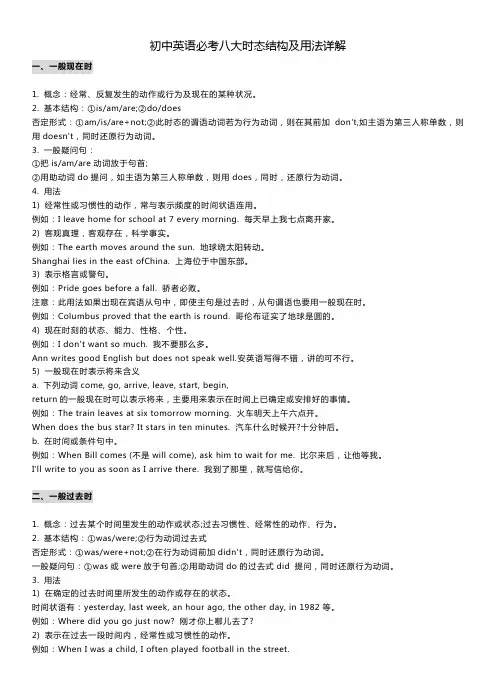
初中英语必考八大时态结构及用法详解一、一般现在时1. 概念:经常、反复发生的动作或行为及现在的某种状况。
2. 基本结构:①is/am/are;②do/does否定形式:①am/is/are+not;②此时态的谓语动词若为行为动词,则在其前加don't,如主语为第三人称单数,则用doesn't,同时还原行为动词。
3. 一般疑问句:①把is/am/are动词放于句首;②用助动词do提问,如主语为第三人称单数,则用does,同时,还原行为动词。
4. 用法1) 经常性或习惯性的动作,常与表示频度的时间状语连用。
例如:I leave home for school at 7 every morning. 每天早上我七点离开家。
2) 客观真理,客观存在,科学事实。
例如:The earth moves around the sun. 地球绕太阳转动。
Shanghai lies in the east ofChina. 上海位于中国东部。
3) 表示格言或警句。
例如:Pride goes before a fall. 骄者必败。
注意:此用法如果出现在宾语从句中,即使主句是过去时,从句谓语也要用一般现在时。
例如:Columbus proved that the earth is round. 哥伦布证实了地球是圆的。
4) 现在时刻的状态、能力、性格、个性。
例如:I don't want so much. 我不要那么多。
Ann writes good English but does not speak well.安英语写得不错,讲的可不行。
5) 一般现在时表示将来含义a. 下列动词come, go, arrive, leave, start, begin,return的一般现在时可以表示将来,主要用来表示在时间上已确定或安排好的事情。
例如:The train leaves at six tomorrow morning. 火车明天上午六点开。
初中英语必考八大时态结构及用法详解初中英语八大时态的结构及用法如下:1. 现在一般时态:基本结构为动词的原型(第三人称单数时动词后面+s, es)。
表示“现在发生的动作、情况、状态和特征”。
常与now,today,this week等时间状语连用。
2. 过去一般时态:基本结构为动词的过去式(动词的过去式在规则动词中直接在原形词尾加-d或-ed,在词尾是e的直接加d,以“辅音字母+y”结尾的动词,先将y改为i,再加-ed)。
表示“过去发生的动作或存在的状态”。
常与yesterday,last week等时间状语连用。
3. 现在进行时态:基本结构为be(am/is/are)+动词的现在分词(动词后面+ing)。
表示“现在正在进行的动作”。
常与now,at the moment等时间状语连用。
4. 过去进行时态:基本结构为was/were+动词的现在分词(动词后面+ing)。
表示“过去正在进行的动作”。
常与at this time yesterday等时间状语连用。
5. 现在完成时态:基本结构为have/has+过去分词(动词后面+ed)。
表示“过去的动作对现在造成的影响或结果”。
常与already,yet,so far等副词连用。
6. 过去完成时态:基本结构为had+过去分词(动词后面+ed)。
表示“过去的动作在过去的某个时间之前已经完成或发生的动作或存在的状态”。
常与by the end of last year,by the time of等时间状语连用。
7. 现在完成进行时态:基本结构为have/has been+动词的现在分词(动词后面+ing)。
表示“动作从过去某时开始,一直延续到现在,或者刚刚完成”。
常与for several days,since等时间状语连用。
8. 过去完成进行时态:基本结构为had been+动词的现在分词(动词后面+ing)。
表示“过去的某个动作从过去某时开始,一直延续到过去的某个时间,或者刚刚完成”。
英语八大时态讲解动词的时态有很多。
初中阶段主要掌握八种:一般现在时、一般过去时、现在进行时、过去进行时、一般将来时、过去将来时、现在完成时、过去完成时。
(一) 一般现在时1)一般现在时态的构成:主语是I, we, you, they和名词复数时作谓语的行为动词用原形。
主语是he, she , it和名词单数时,作谓语的行为动词的词尾变化如下:一般情况+s以s, x, ch, sh 或o结尾+es以辅音+y结尾去y变i+es2)一般现在时态的肯定句、否定句和疑问句形式(以be和like为例):He/ She is a student.I / We/ You/ They/ like music.Many people like music. I am not a student.Is he/ she a student?Do you/ they like music?Do many people like music?3)一般现在时态的用法:现阶段经常性,习惯性的动作。
例如:I get up at six every morning.He plays tennis once a week.举例:A) 现在的状态My mother is a teacher. She teaches English in a school.B) 客观真理The earth goes around the sun.4)常用于一般现在时态的时间状语:often usually sometimes always every day never in the morning 等。
例题解析:举一反三,学的更轻松!1. --- May I help you, sir?--- Yes, I bought the TV the day before yesterday, but it ______.A. didn’t workB. doesn’t workC. won’t workD. can’t work解析:电视虽然是前天买的,但坏了是现在的状态,应该用一般现在时态。
初中英语必考八大时态结构及用法详解一、一般现在时(Simple Present Tense):用法1:表示经常性的、重复性的动作或状态,相当于中文的“经常/总是/通常/偶尔……”。
例句:1. I often go hiking on weekends.(我经常在周末去远足。
)2. They usually play soccer after school.(他们放学后通常踢足球。
)用法2:表示客观真理、科学道理或普遍规律。
例句:1. Water boils at 100 degrees Celsius.(水沸腾时的温度是100摄氏度。
)2. The sun rises in the east and sets in the west.(太阳东升西落。
)二、一般过去时(Simple Past Tense):用法1:表示过去一些时间发生的动作或存在的状态。
例句:1. We went to the beach yesterday.(昨天我们去了海滩。
)2. They lived in London last year.(去年他们住在伦敦。
)用法2:表示过去经常性或重复性的动作。
例句:1. When I was young, I often played hide-and-seek with my friends.(我小时候经常和朋友们玩捉迷藏。
)2. He used to visit his grandparents every summer.(他过去每个夏天都去看望他的祖父母。
)三、一般将来时(Simple Future Tense):用法1:表示将来发生的动作或存在的状态。
例句:1. I will go to the movie tonight.(今晚我将去看电影。
)2. She is going to visit her grandparents next month.(她下个月打算去看望她的祖父母。
八种时态结构及用法
时态是表示动作进行中的时间先后顺序的语法范畴,对于学习语言的人来说,正确理解和运用时态是至关重要的。
本文将介绍八种常用的时态结构及其用法。
一、现在完成时
现在完成时表示动作从过去开始一直延续到现在,并且有可能持续下去。
它的构成是“主语+动词的现在完成时”。
二、过去进行时
过去进行时表示过去某个时间点正在进行的动作,它的构成是“主语+动词的过去进行时”。
三、将来进行时
将来进行时表示将来某个时间点正在进行的动作,它的构成是“主语+动词的将来进行时”。
四、现在进行时
现在进行时表示从过去某个时间点开始持续进行的动作,它的构成是“主语+动词的现在进行时”。
五、过去完成时
过去完成时表示过去的过去,某一动作从过去开始持续延续到现在,或从过去开始持续到现在并将延续下去。
它的构成是“主语+动词的过去完成时”。
六、将来完成时
将来完成时表示将来某一时刻之前发生的动作,或从将来某一时刻开始持续延续到现在的动作,或从将来某一时刻开始持续到现在并将延续下去。
它的构成是“主语+动词的将来完成时”。
七、现在完成进行时
现在完成进行时表示从过去某个时间点开始持续进行的动作,并且从现在开始继续延续。
它的构成是“主语+动词的现在完成进行时”。
八、将来完成进行时
将来完成进行时表示将来某一时刻之前发生的动作,或从将来某一时刻开始持续延续到现在的动作,或从将来某一时刻开始持续到现在并将延续下去。
它的构成是“主语+动词的将来完成进行时”。
综上所述,八种时态结构各有用途,我们需要根据具体语境和句子结构来正确使用它们,以使表达准确、清晰。
八大时态的结构与用法
英语中主要有八大时态,它们的结构和用法如下:
- 现在时:表示经常性或习惯性的动作或状态,或者表示现在正在进行的动作。
常用的句式结构是:主语+动词原形+其他。
- 现在进行时:表示正在进行的动作,或者现在的某个动作正在发生。
常用的句式结构是:主语+be动词(am/is/are)+动词的现在分词+其他。
- 现在完成时:表示过去某个时间开始,一直持续到现在的动作或状态。
常用的句式结构是:主语+have/has+动词的过去分词+其他。
- 过去时:表示过去某个具体时间发生的动作或状态。
常用的句式结构是:主语+动词的过去式+其他。
- 过去进行时:表示过去某个具体时间正在进行的动作。
常用的句式结构是:主语+was/were+动词的现在分词+其他。
- 过去完成时:表示过去某个时间之前完成的动作。
常用的句式结构是:主语+had+动词的过去分词+其他。
- 将来时:表示将来某个时间会发生的动作或状态。
常用的句式结构是:主语+will+动词原形+其他。
- 将来进行时:表示将来某个具体时间正在进行的动作。
常用的句式结构是:主语+will be+动词的现在分词+其他。
英语时态8种基本时态讲解一.概念:英语中表示不同时间发生的动作或存在的状态,需用不同的动词形式表示,这种不同的动词形式称为时态。
二.种类:(基本时态)一般现在时一般过去时现在进行时过去进行时一般将来时过去将来时现在完成时过去完成时三.用法:1)一般现在时表示经常发生或习惯性的动作或状态及客观现实和普遍真理。
一般现在时常以动词原形表示,但当主语是第三人称单数时,动词词尾加-s或-es。
2)句型结构:主语+V.(包括be动词)+宾语+…She is an engineer.He has breakfast at 6:00every day.3)注意:一般现在时通常与always , often , usually , every day , sometimes , once a week 等时间状语连用。
1)一般过去时表示发生在过去的动作或存在的状态,通常与表示过去的时间状语yesterday, last night ,some years ago, in 1990,in those days.等连用。
I was a student 6 years ago.2)句型结构:主语+V.过去时+宾语+…例句:昨天他很忙3)否定句和疑问句。
a)----He was busy yesterday. -----He wasn’t busy.-----Was he busy?-----Yes, he was./ No, he wasn’t.4)动词过去式变化规则。
a)一般情况下的词加-ed.work---worked call----calledb)以不发音的字母e结尾的单词直接加-d .live----lived change----changed smoke----smoked die----died graduate----graduated drive----drovec)以“辅音字母+y”结尾的单词,变y为i加-ed.study----studied carry----carried cry----criedtry----tried marry----marriedd)以“元音字母+y”结尾的单词直接加-ed.play----played stay----stayede)以“一个元音字母+一个辅音字母”结尾的单词应先双写这个辅音字母然后再加-ed.stop----stopped plan----planned pat----pattedf)动词不规则变化:do----did go----went come----came run----ran write----wrote begin----began drink----drank keep----kept leave----left sleep----slept make----made lie----lay dig----dug eat----ate know----knewcut----cut set----set let----let read----read hurt----hurt 例句:我前天拿走了这本书。
英语八大时态用法详解一.一般现在时1. 概念:表示经常、反复发生的动作或行为及现在的某种状况。
2. 基本结构:(1)主语+ be动词(is / am / are)+表语(2)主语+ 行为动词的原形或单数第三人称形式+其他(3)There be 句型:There is / are +n. +介词短语is / are 根据n. 的单复数决定。
否定形式:(1)am / is /are + not;(2)谓语动词若为行为动词,则在其前加don’t,如主语为第三人称单数,则用doesn’t,同时行为动词还原为原形。
(3)There is / are not +n. +介词短语一般疑问句:(1)把is / am / are动词放于句首;(2)用助动词do提问,如主语为第三人称单数,则用does,同时还原行为动词;(3))There is / are +n. +介词短语: is / are动词放于句首。
3.标志性时间状语:(1)on + 星期s = every 星期(2)once / twice/ three times a week (month / year …) (3)频度副词always / usually / often / sometimes=at times= (every)once in a while / seldom / never(不绝对)(4)in the mornings / afternoons / evenings = every morning / afternoon/ evening 4.用法:(1)表示经常性或习惯性的动作,常与表示频度的时间状语连用。
如:I leave home for school at 7 every morning.(2)表示客观真理,客观存在或科学事实。
如:The earth moves around the sun.(3)表示格言或警句。
如:Pride goes before a fall. 骄者必败。
注意:此用法如果出现在宾语从句中,即使主句是过去时,从句谓语也要用一般现在时。
如:Columbus proved that the earth is round.(4)表示现在时刻的状态、能力、性格、个性等。
如:I don’t want so much.Ann writes good English but does not speak well.(5)一般现在时表示将来含义①come, go, arrive, leave, start, begin, return的一般现在时可以表示将来,主要用来表示在时间上已确定或安排好的事情。
如:The train leaves at six tomorrow morning.—When does the bus star?—It stars in ten minutes.②在时间或条件状语句中。
如:When Bill comes (不是will come), ask him to wait for me.I’ll write to you as soon as I arrive there.二.一般过去时1. 概念:表示过去某个时间里发生的动作或状态;过去习惯性、经常性的动作或行为。
2. 基本结构:(1)主语+ was / were +表语(2)主语+ 行为动词的过去式+其他(3)There be 句型:There was / were +n. +介词短语(4)主语+could+动词原形(5)主语+used to do sth否定形式:(1)was / were + not;(2)在行为动词前加didn’t,同时还原行为动词。
(3)There was / were not +n. +介词短语(4)主语+could not +动词原形(5)主语+used not to do sth或主语+didn’t use to do sth一般疑问句:(1)was或were放于句首;(2)用助动词do的过去式did 提问,同时还原行为动词;(3)There was / were +n. +介词短语:was或were放于句首;(4)could放于句首;(5)Used主语+ to do sth或Did+主语+use to do sth3.时间状语:(1)last 短语(2)时间段+ago (3)yesterday及yesterday短语(4)at the age of = when sb. was+年龄(5)in one’s teens / twenties(6)固定短语:just now=a moment ago, one day, from then on, at that time, the day before yesterday, before, long before, in the past , in the / early old days, in the ancient days, in the ancient + 国家,long long ago = once upon a time (故事的开头)4. 用法:(1)在确定的过去时间里所发生的动作或存在的状态。
如:Where did you go just now?(2)表示在过去一段时间内,经常性或习惯性的动作。
如:When I was a child, I often played football in the street.注意:used to do sth“过去常常做某事”,表示过去习惯性的动作或状态,但如今已不存在。
如:Mother used not to be so forgetful. 妈妈过去没这么健忘。
(3)用于时间状语从句a. 由when 引导的时间状语从句,从句用一般过去时态,主句用过去进行时态。
如:His mother was cooking when he came back.b. 由since/before 引导的时间状语从句,从句用一般过去时态,主句用现在完成时态。
如:I have made many friends since I came to China.It has been/is 15 years since I was a teacher.It has been/is 15 years before he knew it. 不知不觉15 年过去了。
c. 由when / by the time/ before引导的时间状语从句,从句用一般过去时态,主句用过去完成时态。
如:The plane had taken off when / by the time we arrived at the airport.The Enlish class had begun before I got to school.三.现在进行时1. 概念:表示现阶段或说话时正在进行的动作及行为。
2. 基本结构:主语+ am / is /are + doing否定形式:主语+ am / is / are + not + doing一般疑问句:把be动词放于句首。
3.时间状语:(1)now (2)at this time = at this / the moment (3)Look!/Look at …!(4)Listen! / Listen to …!(5)these days / months / years(6)It is+ 时间点/日期/星期4. 用法:(1)表示现在(指说话人说话时)正在发生的事情。
如:We are waiting for you.(2)表示长期的或重复性的动作,说话时动作未必正在进行。
如:Mr Green is writing another novel. (说话时并不一定在写小说)(3)表示动作的渐变,这样的动词有:get, grow, become, turn, run, go, begin等。
如:The leaves are turning red.It’s getting warmer and warmer.(4)与always, constantly, forever 等词连用,表示反复发生的动作或持续存在的状态,往往带有说话人的主观色彩。
如:You are always changing your mind. 你老是改变主意。
(5)用现在进行时表示将来下列动词come, go, arrive, leave, start, begin, return等瞬间动词的现在进行时可以表示将来。
如:I’m leaving tomorrow.四.过去进行时1. 概念:表示过去某段时间或某一时刻正在发生或进行的行为或动作。
如:My brother fell while he was riding his bicycle and hurt himself.2. 基本结构:主语+ was / were + doing否定形式:主语+ was / were + not + doing一般疑问句:把was或were放于句首。
3. 时间状语:(1)at that time(2)at this time+过去的时间(3)It was+ 时间点/ 日期/ 星期(过去)(4)from A时间to B时间+过去的时间4. 用法:(1)过去进行时表示过去某段时间内持续进行的动作或者事情。
如:We were watching TV from seven to nine last night.(2)过去进行时可以表示在过去某个时间点发生的事情。
时间点可以用介词短语、副词或从句来表示。
如:What was she doing at nine o’clock yesterday? (介词短语表示时间点) She was doing her homework then. (副词表示时间点)When I saw him he was decorating his room. (when从句表示时间点)(3)在复合句中,如果主要动作和背景动作都是延续的或同时发生的,那么主从句的动词都可用过去进行时。
如:When he was waiting for the bus, he was reading a newspaper. (两个动作都是延续的)He was cleaning his car while I was cooking. (两个动作同时进行或主句的动作发生在从句的动作过程中)五.一般将来时1. 概念:表示将要发生的动作或存在的状态及打算、计划或准备做某事。
2. 基本结构:(1)主语+ am / is / are / going to do sth(2)主语+ will do sth(3)主语+ am / is /are t to do sth (4)主语+ am / is /are about to do sth否定形式:(1)主语+ am / is /are + not + going to do sth(2)主语+ will not(won’t)do sth (3)主语+ am / is /are not t to do sth (4)主语+ am / is /are not about to do sth 一般疑问句:(1)am / is / are放于句首;(2)will置于句首。